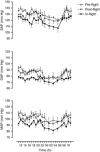Fluid shifts, vasodilatation and ambulatory blood pressure reduction during long duration spaceflight
- PMID: 25774397
- PMCID: PMC4324706
- DOI: 10.1113/jphysiol.2014.284869
Fluid shifts, vasodilatation and ambulatory blood pressure reduction during long duration spaceflight
Abstract
Key points: Weightlessness in space induces initially an increase in stroke volume and cardiac output, accompanied by unchanged or slightly reduced blood pressure.It is unclear whether these changes persist throughout months of flight.Here, we show that cardiac output and stroke volume increase by 35–41% between 3 and 6 months on the International Space Station, which is more than during shorter flights.Twenty-four hour ambulatory brachial blood pressure is reduced by 8–10 mmHg by a decrease in systemic vascular resistance of 39%, which is not a result of the suppression of sympathetic nervous activity, and the nightly dip is maintained in space.It remains a challenge to explore what causes the systemic vasodilatation leading to a reduction in blood pressure in space, and whether the unexpectedly high stroke volume and cardiac output can explain some vision acuity problems encountered by astronauts on the International Space Station.
Abstract: Acute weightlessness in space induces a fluid shift leading to central volume expansion. Simultaneously, blood pressure is either unchanged or decreased slightly. Whether these effects persist for months in space is unclear. Twenty-four hour ambulatory brachial arterial pressures were automatically recorded at 1–2 h intervals with portable equipment in eight male astronauts: once before launch, once between 85 and 192 days in space on the International Space Station and, finally, once at least 2 months after flight. During the same 24 h, cardiac output (rebreathing method) was measured two to five times (on the ground seated), and venous blood was sampled once (also seated on the ground) for determination of plasma catecholamine concentrations. The 24 h average systolic, diastolic and mean arterial pressures (mean ± se) in space were reduced by 8 ± 2 mmHg (P = 0.01; ANOVA), 9 ± 2 mmHg (P < 0.001) and 10 ± 3 mmHg (P = 0.006), respectively. The nightly blood pressure dip of 8 ± 3 mmHg (P = 0.015) was maintained. Cardiac stroke volume and output increased by 35 ± 10% and 41 ± 9% (P < 0.001); heart rate and catecholamine concentrations were unchanged; and systemic vascular resistance was reduced by 39 ± 4% (P < 0.001). The increase in cardiac stroke volume and output is more than previously observed during short duration flights and might be a precipitator for some of the vision problems encountered by the astronauts. The spaceflight vasodilatation mechanism needs to be explored further.
Figures



Comment in
-
Mighty hearts in space.J Physiol. 2015 Feb 1;593(3):485. doi: 10.1113/jphysiol.2015.270000. J Physiol. 2015. PMID: 25774392 Free PMC article. No abstract available.
References
-
- Baevsky RM, Baranov VM, Funtova II, Diedrich A, Pashenko AV, Chernikova AG, Drescher J, Jordan J. Tank J. Autonomic cardiovascular and respiratory control during prolonged spaceflights aboard the International Space Station. J Appl Physiol. 2007;103:156–161. - PubMed
-
- Bringard A, Pogliaghi S, Adami A, Roia GD, Lador F, Lucini D, Pizzinelli P, Capelli C. Ferretti G. Cardiovascular determinants of maximal oxygen consumption in upright and supine posture at the end of prolonged bed rest in humans. Resp Physiol Neurobiol. 2010;172:53–62. - PubMed
-
- Buckey JC, Jr, Gaffney FA, Lane LD, Levine BD, Watenpaugh DE, Wright SJ, Yancy CW, Jr, Meyer DM. Blomqvist CG. Central venous pressure in space. J Appl Physiol. 1996;81:19–25. - PubMed
-
- Chobanian AV, Bakris GL, Black HR, Cushman WC, Green LA, Izzo JL, Jr, Jones DW, Materson BJ, Oparil S, Wright JT., Jr Rocella EJ. Seventh report of the Joint National Committee on Prevention, Detection, Evaluation and Treatment of High Blood Pressure. Hypertension. 2003;42:1206–1252. - PubMed
-
- Cooke WH, Ames IVJE, Crossman AA, Cox JF, Kuusela TA, Tahvanainen KUO, Moon LB, Drescher J, Baisch FJ, Mano T, Levine BD, Blomqvist CG. Eckberg DL. Nine months in space: effects on human autonomic cardiovascular regulation. J Appl Physiol. 2000;89:1039–1045. - PubMed
Publication types
MeSH terms
Substances
LinkOut - more resources
Full Text Sources
Other Literature Sources

